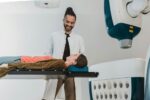
Table of Contents
Getting ready for Match Day? We break down the competition based on the most recent Match year to bring you the most competitive medical residencies. Knowing which specialization programs were the most competitive last year helps when applying for residency.
The top 10 most highly competitive specialties in 2025 were:
- Dermatology
- Neurosurgery
- Plastic Surgery
- Radiation Oncology
- Diagnostic Radiology
- Orthopedic Surgery
- Interventional Radiology
- Otolaryngology
- General Surgery
- Anesthesiology
What factors make a medical residency program highly competitive? A specialty’s competitiveness is based on various factors, including position fill rate, number of applicants, average USMLE scores, and research/publication numbers.
Want to increase your chances of success on Match Day 2026? Qualified consultants at MedSchoolCoach are ready to make your residency application stand above the crowd.
How We Determined Which Residencies Are Most Competitive
Creating a list of the most competitive residencies within the medical field isn’t just a matter of comparing total applicants to open positions.
We created a custom methodology that includes the number of successful matches, average Step 2 CK score, and mean number of published abstracts, presentations, and publications to rank all major specialties from most to least competitive. Adding these factors together gave us a single competitiveness score for each residency, and our final list organizes each specialty from highest to lowest competitiveness score.
The data we used for this ultimate guide comes from the following sources:
- NRMP’s Advanced Match Data (2025)
- NRMP Match’s 2024 Match Summary for MD Seniors
- Charting Outcomes™: Characteristics of U.S. MD Seniors Who Matched to Their Preferred Specialty: 2024 Main Residency Match®
- Doximity’s 2024 Physician Compensation Report (Post-Medical Education)
What is the hardest residency to match into? The hardest residency to match into is dermatology, and this is true in virtually any given year. Not only are there very few positions available for the total number of applicants, but successful dermatology residents also boast very high Step 2 CK scores and have a higher-than-average number of abstracts, presentations, and publications on their CVs.
Learn More: A Guide to Residency Program Signals — Should You Use Them?
1. Dermatology
Percentage of applicants who successfully matched to this specialty: 10.03%
Number of PGY-1 positions: 30
Number of applicants: 299
Match rate: 100%
Mean USMLE Step 2 CK score: 257 (Matched), 250 (Unmatched)
Mean number of abstracts, presentations, and publications: 27.7 (Matched), 19 (Unmatched)
Average salary after residency: $493,659
Dermatology is one of the most sought-after specialties because of the relatively high work-life balance. It helps that dermatologists typically have lucrative salaries and fewer on-call responsibilities.
But this compelling specialty is for those passionate about medical and surgical treatment of skin conditions, not just the money. Only about 10% of applicants get matched because of how competitive this specialty is.
2. Neurosurgery
Percentage of applicants who successfully matched to this specialty: 55.67%
Number of PGY-1 positions: 268
Number of applicants: 476
Match rate: 98.9%
Mean USMLE Step 2 CK score: 255 (Matched), 247 (Unmatched)
Mean number of abstracts, presentations, and publications: 37.4 (Matched), 31.8 (Unmatched)
Average salary after residency: $763,908
Neurosurgery (or neurological surgery) is a surgical specialty known for its intricate procedures, extended training period (6 years instead of 4 years), and the highest expected salary of any medical specialty.
To successfully match, we recommend substantial clinical rotations and research experience in the field. Students who land neurosurgery residencies average the highest number of abstracts, presentations, and publications of any major specialty.
Related: How Competitive is a Neurology Residency?
3. Plastic Surgery
Percentage of applicants who successfully matched to this specialty: 74.92%
Number of PGY-1 positions: 221
Number of applicants: 295
Match rate: 100%
Mean USMLE Step 2 CK score: 256 (Matched), 247 (Unmatched)
Mean number of abstracts, presentations, and publications: 34.7 (Matched), 26.3 (Unmatched)
Average salary after residency: $619,812
Plastic surgery residents have among the highest Step 2 CK scores, the fourth highest salary expectations, and a significant number of unmatched applicants. This specialty may be so competitive because of the unique aesthetic aspect, the less strenuous on-call duties, and the high-paying clientele.
Among other things, you’ll need a strong personal statement to stand a chance against the large pool of competitive candidates.
4. Radiation Oncology
Percentage of applicants who successfully matched to this specialty: 7.69%
Number of PGY-1 positions: 12
Number of applicants: 156
Match rate: 100%
Mean USMLE Step 2 CK score: 252 (Matched), 242 (Unmatched)
Mean number of abstracts, presentations, and publications: 15.9 (Matched), 13.5 (Unmatched)
Average salary after residency: $569,170
Radiation oncology focuses on radiation therapy as a treatment plan for cancer. Although step scores are slightly lower than other specialties on this list, radiation oncology requires a strong knowledge of biology, physics, and clinical skills.
What makes it competitive is the healthy salary (#5 on this list), the low number of available positions (#1 on this list), and the high demand for treating cancer (the #2 cause of death in America).
5. Diagnostic Radiology
Percentage of applicants who successfully matched to this specialty: 13.27%
Number of PGY-1 positions: 151
Number of applicants: 1108
Match rate: 97%
Mean USMLE Step 2 CK score: 256 (Matched), 241 (Unmatched)
Mean number of abstracts, presentations, and publications: 12 (Matched), 8 (Unmatched)
Average salary after residency: $531,983
Diagnostic radiology is a medical specialty that uses imaging techniques, such as X-rays, CT scans, MRI, and ultrasound, to diagnose and sometimes treat patients. Often referred to as the “doctor’s doctor,” diagnostic radiologists play a vital role across all specialties, requiring strong analytical skills and familiarity with advanced technology.
This specialty is competitive due to its high average salary, the relatively low number of PGY-1 positions, and strong demand across diverse practice areas. It’s also incredibly appealing for its excellent work-life balance, which typically includes structured shifts that reduce the chances of unpredictable scheduling or long hours.
6. Orthopedic Surgery
Percentage of applicants who successfully matched to this specialty: 58.43%
Number of PGY-1 positions: 929
Number of applicants: 1590
Match rate: 100%
Mean USMLE Step 2 CK score: 257 (Matched), 246 (Unmatched)
Mean number of abstracts, presentations, and publications: 23.8 (Matched), 18 (Unmatched)
Average salary after residency: $654,815
The high earning potential and the diverse hands-on nature of the work make this a top choice in the medical field. Surgeons are always in high demand, and orthopedic surgery offers relatively more work-life balance than many other surgical fields while still offering significant salary expectations post-residency.
With this specialty, expect a 5-year residency and a 1- to 2-year fellowship. You can increase your chance of matching with extensive orthopedic surgery rotation experience and improving your total number of published research pieces.
7. Interventional Radiology
Percentage of applicants who successfully matched to this specialty: 17.39%
Number of PGY-1 positions: 52
Number of applicants: 299
Match rate: 100%
Mean USMLE Step 2 CK score: 253 (Matched), 245 (Unmatched)
Mean number of abstracts, presentations, and publications: 15.8 (Matched), 10.1 (Unmatched)
Average salary after residency: $531,983
Interventional radiology (IR) involves an interplay of diagnostic and therapeutic procedures. Interventional radiologists utilize minimally invasive image-guided techniques to treat a variety of conditions, adding to the field’s attractiveness.
The slightly lower average Step scores may reduce the competitiveness, but still, only 17% of applicants were matched last year. As interventional radiology continues to expand, it remains one of the most competitive medical residencies.
8. Otolaryngology
Percentage of applicants who successfully matched to this specialty: 71.20%
Number of PGY-1 positions: 394
Number of applicants: 552
Match rate: 99.7%
Mean USMLE Step 2 CK score: 256 (Matched), 251 (Unmatched)
Mean number of abstracts, presentations, and publications: 20 (Matched), 15.6 (Unmatched)
Average salary after residency: $502,543
Often referred to as Ear, Nose, and Throat (ENT), otolaryngology has a diverse range of subspecialties. These include pediatric otolaryngology, head and neck surgery, laryngology, and rhinology.
This diversity offers a wide range of practice options for specialists, adding to the specialty’s appeal. Successful applicants have the second-highest average Step 2 CK score across all of the specialties and the fifth-highest mean number of published research pieces.
9. General Surgery
Percentage of applicants who successfully matched to this specialty: 53.68%
Number of PGY-1 positions: 1778
Number of applicants: 3305
Match rate: 99.8%
Mean USMLE Step 2 CK score: 253 (Matched), 238 (Unmatched)
Mean number of abstracts, presentations, and publications: 10.9 (Matched), 7.3 (Unmatched)
Average salary after residency: $464,071
General surgery focuses on the surgical care of abdominal organs, including the stomach, intestines, liver, pancreas, gallbladder, and appendix. Surgeons combine technical precision with high-stakes decision-making and play a critical role in patient care.
This PGY-1 position is also the path some surgeons take before moving into more precise surgical specialization.
Successful applicants to the general surgery specialty (also referred to as Surgery-Categorical in AAMC data) have slightly lower Step 2 CK scores and the second-lowest number of total publications on this top 10 list. However, the sheer number of applicants to available positions pushes this focus into a top spot for competitiveness.
10. Anesthesiology
Percentage of applicants who successfully matched to this specialty: 59.79%
Number of PGY-1 positions: 1805
Number of applicants: 3017
Match rate: 99.9%
Mean USMLE Step 2 CK score: 252 (Matched), 240 (Unmatched)
Mean number of abstracts, presentations, and publications: 9 (Matched), 5.4 (Unmatched)
Average salary after residency: $494,522
Anesthesiology is an ever-evolving specialty with high salary potential, strong job security, and high work-life balance. No wonder it’s a highly competitive residency specialty. You may complete a 1- to 2-year fellowship after residency, particularly if you want to focus on a subspecialty within anesthesiology, such as pediatric or neurosurgical anesthesiology.
There are far fewer applicants than total available positions, but successful anesthesiology residents don’t need quite as many publications or as remarkably high a Step 2 CK score compared to the rest of our list.
Read More: Top Tips for Residency Interview
The 5 Least Competitive Specialties
While a handful of specialties are difficult to match into, other worthwhile residency programs are less competitive — though still challenging and rewarding.
It’s important to note that less competition and more positions really does not mean these specialties are easier or worse. These specialties are simply less competitive, starting with the lowest competitiveness according to our methodology:
- Psychiatry (1,705 applicants to 2,388 positions, 99.7% matched, 246 Step 2 CK score) — Despite the increasing demand for these services, this mental health specialty may face less competition due to social stigma. The average expected salary ranks in the bottom half, but available positions continue to increase at a higher rate than most specialties.
- Family Medicine (7,337 applicants to 5,357 positions, 85% matched, 244 Step 2 CK score) — This primary care specialty is typically less competitive. It ranks #2 in positions available after internal medicine, and it ranks in the bottom 15 for expected salary.
- Emergency Medicine (3,753 applicants to 3,068 positions, 97.9% matched, 248 Step 2 CK score) — This is a less competitive specialty, due to the high-stress environment and unusual work hours. However, the expected salary squeaks into the top 20.
- Pediatrics (3,998 applicants to 3,135 positions, 95.3% matched, 247 Step 2 CK score) — This specialty, though vital to children’s health, is typically less competitive, possibly due to the relatively low salary. However, many applicants are passionate about children in particular.
- Physical Medicine & Rehab (346 applicants to 240 positions, 69.4% matched, 248 Step 2 CK score) — Referred to as PM&R, the physiatry specialty promotes healing and patient rehab. The salary, work-life balance, and relatively low competitiveness make this specialty very attractive to students looking for a career in a long-term, patient-centric specialty.
Read Next: A How-To Guide on Letters of Intent for Residency
How Can I Increase My Chances of Matching Into a Competitive Residency?
Yes, there are a few ways you can increase your chances of matching competitively, such as catering your clinical hours to your specialty of choice, interview training, or hiring application consultants.
Choosing a specialty after medical school is a deeply personal decision that should align with your interests, skills, and long-term healthcare career goals. It’s about finding the right fit for you and where you can make the most meaningful contribution to patient care.
Our seasoned physician advisors can provide mentorship and guidance on how to achieve your dream residency position. We happily advise on elective rotations, letters of recommendation, the ERAS process, and anything you need to match with the most competitive specialties.
Schedule a free consultation with MedSchoolCoach mentors to see how to increase your chances of matching into the residency of your choice.

David Flick
Dr. Flick graduated Magna Cum Laude from Loyola Marymount University in Los Angeles, California, with a bachelor’s degree in biology. During his time there, he was actively involved in high school and collegiate tutoring. After graduation, Dr. Flick moved to Chiang Mai, Thailand, where he taught high school mathematics at an international baccalaureate school. Before beginning medical school, he spent two years volunteering with international medical aid programs, working in seven different countries throughout Asia.
Dr. Flick then attended medical school at UC Irvine, supported by an Army Health Professions Scholarship. While there, he served on the admissions committee for four years and participated in the selection committee board. After medical school, he completed a family medicine residency in Oahu, Hawaii, where he also contributed to the residency admissions committee. Dr. Flick is board certified in family medicine and currently works as a flight surgeon for the Army.





